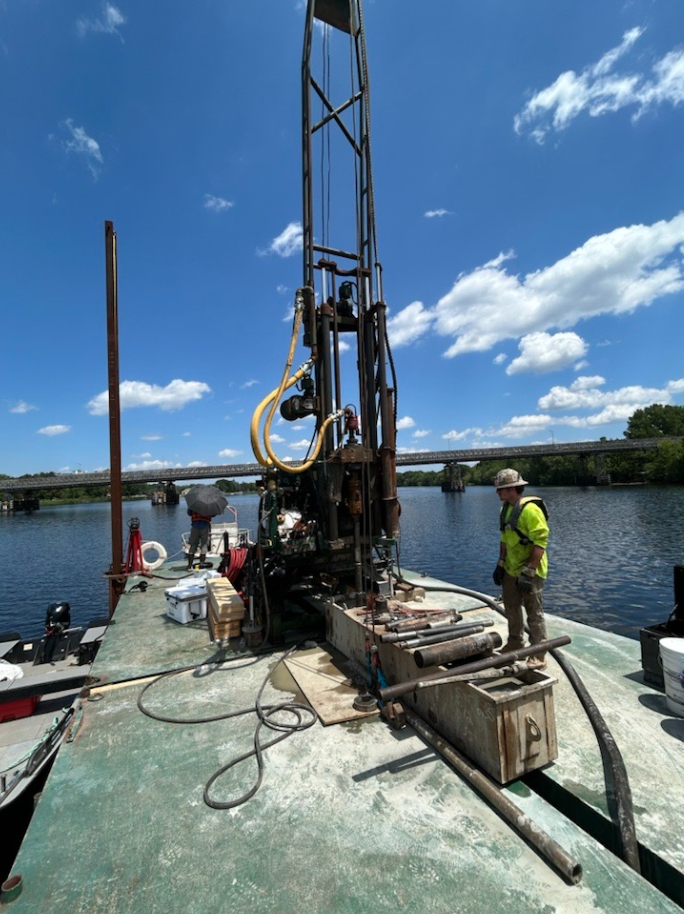 Massachusetts Department of Transportation
Massachusetts Department of Transportation Daily commuters over the Rourke Bridge in Lowell, Massachusetts, will soon be able to breathe a sigh of relief during their drive. The paradoxically long-lived yet temporary bridge is being replaced by a permanent structure that will have ample room for drivers, bikers, and pedestrians.
Originally constructed in 1983, the temporary Rourke Bridge was planned to last a few years. Decades later, approximately 27,000 vehicles drive over the metal-plated structure each day. For decades, the bridge has been on the state’s replacement list, but funding was tight.
Further reading:
- Buffalo community comes together to shape, celebrate pedestrian bridge
- How Pittsburgh’s Fern Hollow Bridge was replaced in less than a year
- First-ever pedestrian bridge inspection process proposed
“It’s a big project, and we have struggled for a number of years to fund it,” said Jonathan Gulliver, ENV SP, the undersecretary of transportation and highway administrator at the Massachusetts Department of Transportation. “This was the first bridge on our list” when the Infrastructure Investment and Jobs Act became law in 2021, Gulliver said.
After planning and design efforts and a series of public and working group meetings, initial site investigations kicked off in summer 2025. Construction of the new Rourke Bridge is slated to be complete with the crossing open to traffic by 2029.
White-knuckle commutes
In the early 1980s, it became clear that a bridge over the Merrimack River into Lowell would be a helpful connection for drivers. During the initial discussions about placements and construction, the possibility of a temporary structure was suggested. This two-lane, metal-plated bridge could be constructed in a few months and act as a temporary solution. In 1983, the narrow, temporary bridge was built with the intention of it serving as a solution for 4-5 years – until a replacement could be constructed.
Four decades later, the “temporary” bridge is still open to commuters.
Traversing the narrow and well-traveled Rourke Bridge is a harrowing feat for many commuters. Drivers report praying as they grip their steering wheels or calling loved ones for moral support as they bump over the road plates, according to CBS News. Anyone standing near the bridge is engulfed in a cacophony of noise as cars bang their way over the span. A metalworker who lives in Lowell likened the noise to “a marching band,” according to the same report.
“Whenever I think of this bridge, I think of our (U.S.) Congresswoman Lori Trahan, who was a real, huge advocate for this project,” Gulliver recalled. For Trahan, who grew up in Lowell, the bridge played a central role as she was learning to drive decades ago.
“When I got my driver’s license, I crossed the bridge, white-knuckled in my dad’s old pickup truck,” Trahan said at the groundbreaking for the new bridge. “If you’ve ever felt that bridge sway under your tires or braced yourself as cars squeezed past in the opposite direction, you know exactly what I mean.”
Beyond the aging infrastructure of the current Rourke Bridge, the span is also lacking in some key safety and accessibility features. While there is a caged pedestrian path, the space is narrow and not Americans with Disabilities Act-compliant. The narrow bridge also doesn’t leave space for emergency vehicles to pass, slowing important responses to critical situations.
Planning a replacement
Discussions about the Rourke bridge replacement have been ongoing over the years, with current planning beginning in 2013. The MassDOT team conducted feasibility studies, hosted community discussions, and collaborated with city and engineering representatives.
“Anytime we have a big project like this, we do a lot of work with the communities. That includes not just the elected officials at the city hall but also the community groups and neighborhoods advocates,” Gulliver said.
Through the process, the team considered three options for the new bridge: 1) keep the current bridge footprint, 2) construct a new bridge slightly offset to the temporary bridge, or 3) build a more curved construction with the north footings moved westward.
After considering traffic, safety, waterway access, environmental issues, design options, and price, the team chose alternative 3. This option would also allow for the current bridge to remain open through the construction process.
 Massachusetts Department of Transportation
Massachusetts Department of TransportationThe new Rourke Bridge is a design-build project, Gulliver said.
He explained that the MassDOT team and a consultant of record kick-started the project planning, completing about 25% of the design. This included working on the preferred alternatives, completing the permitting, and creating the technical concepts of the structure. The team then opened the project to bids.
“We only go up to 25% … to give (the bidding contractors) as much opportunity as possible to come up with some innovative ways to approach the work,” he said. Gulliver added that this model encourages contractors and their design team to find ways to build the project more efficiently and suggest fresh ideas in construction or design, all while keeping overhead down.
The new bridge design reflects these creative endeavors. The new bridge will be widened, creating four lanes of traffic, shoulders, and wide pedestrian and biking paths. As part of the pedestrian and bike path design, there will be six curvilinear pedestrian overlooks and boat-shaped benches (inspired by boats that race along this section of the Merrimack River).
Skanska won the roughly $300 million contract for Rourke Bridge construction. Initial work on the project started in June 2025, including in-water soil borings in the Merrimack River, on-street soil borings, survey work, and test pit excavations to verify subsurface conditions and utility locations. Skanska is also installing erosion control measures in preparation for tree and vegetation removal on the riverbanks.
Gulliver noted that MassDOT and Skanska have a great working relationship and have collaborated before on big projects. “They're a firm we do a ton of work with,” he said. “We are really confident in their approach to this, so we're really happy to have them
on board.”



